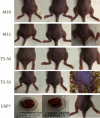Preclinical Evaluation of the Tumorigenic and Immunomodulatory Properties of Human Bone Marrow Mesenchymal Stromal Cell Populations with Clonal Trisomy 5
- PMID: 36035513
- PMCID: PMC9417782
- DOI: 10.1155/2022/1613636
Preclinical Evaluation of the Tumorigenic and Immunomodulatory Properties of Human Bone Marrow Mesenchymal Stromal Cell Populations with Clonal Trisomy 5
Abstract
Cytogenetic aberrations may emerge in human mesenchymal stromal cells (MSC) during ex vivo expansion for cell therapy. We have detected clonal trisomy 5 in two distinct autologous MSC products expanded from bone marrow which, based on the current quality control criteria, could not be released for clinical use. Although a safety concern, it is still unclear to what extent recurrent aneuploidies detected in MSC products may affect the threshold for neoplastic transformation or the medicinal properties of these cells. We have carried out an exploratory preclinical study to evaluate these MSC products with clonal trisomy 5, regarding their oncogenic and immunomodulatory potential. Cell population growth in vitro was reduced in MSC cultures with clonal trisomy 5 compared with the population growth of their euploid MSC counterparts, based on a lower cumulative population doubling level, reduced cell proliferation index, and increased senescence-associated beta-galactosidase activity. Subcutaneous injection of clinically relevant amount of MSC population, either with or without clonal trisomy 5, did not generate tumors in immunodeficient mice within a follow-up period of six months. Most importantly, MSC population with clonal trisomy 5 kept immunomodulatory properties upon interferon gamma (IFNγ) licensing, displaying overexpression of IDO, CXCL9, CXCL10, and CXCL11, in a similar fashion than that of IFNγ-licensed euploid MSC. Our findings suggest that bone marrow MSC products with clonal trisomy 5 may retain their therapeutic potential, based on poor tumor initiating capability and preserved immunomodulatory potency. This preclinical evidence may further support the definition of release criteria of autologous MSC products for cell therapy under critical clinical scenarios. This trial is registered with Clinical Study registration number: RBR-29x2pr.
Copyright © 2022 Maria Susana Joya Marodin et al.
Conflict of interest statement
The authors declare that they have no conflicts of interest.
Figures




Similar articles
-
Emergence of clonal chromosomal alterations during the mesenchymal stromal cell cultivation.Mol Cytogenet. 2015 Dec 1;8:94. doi: 10.1186/s13039-015-0197-5. eCollection 2015. Mol Cytogenet. 2015. PMID: 26628918 Free PMC article.
-
Licensing microgels prolong the immunomodulatory phenotype of mesenchymal stromal cells.Front Immunol. 2022 Aug 18;13:987032. doi: 10.3389/fimmu.2022.987032. eCollection 2022. Front Immunol. 2022. PMID: 36059508 Free PMC article.
-
Xenotransplantation of interferon-gamma-pretreated clumps of a human mesenchymal stem cell/extracellular matrix complex induces mouse calvarial bone regeneration.Stem Cell Res Ther. 2017 Apr 26;8(1):101. doi: 10.1186/s13287-017-0550-1. Stem Cell Res Ther. 2017. PMID: 28446226 Free PMC article.
-
Increased Mesenchymal Stem Cell Functionalization in Three-Dimensional Manufacturing Settings for Enhanced Therapeutic Applications.Front Bioeng Biotechnol. 2021 Feb 12;9:621748. doi: 10.3389/fbioe.2021.621748. eCollection 2021. Front Bioeng Biotechnol. 2021. PMID: 33644016 Free PMC article. Review.
-
Strategies to enhance immunomodulatory properties and reduce heterogeneity in mesenchymal stromal cells during ex vivo expansion.Cytotherapy. 2022 May;24(5):456-472. doi: 10.1016/j.jcyt.2021.11.009. Epub 2022 Feb 25. Cytotherapy. 2022. PMID: 35227601 Review.
Cited by
-
The risk factors, pathogenesis and treatment of premature ovarian insufficiency.J Ovarian Res. 2025 Jun 18;18(1):134. doi: 10.1186/s13048-025-01714-2. J Ovarian Res. 2025. PMID: 40533774 Free PMC article. Review.
-
Bone marrow mesenchymal stem cells in premature ovarian failure: Mechanisms and prospects.Front Immunol. 2022 Oct 27;13:997808. doi: 10.3389/fimmu.2022.997808. eCollection 2022. Front Immunol. 2022. PMID: 36389844 Free PMC article.
-
Chromosomal abnormalities of mesenchymal stromal cells in hematological malignancies.Oncogene. 2025 Aug 14. doi: 10.1038/s41388-025-03528-4. Online ahead of print. Oncogene. 2025. PMID: 40813803 Review.
References
LinkOut - more resources
Full Text Sources
Research Materials

